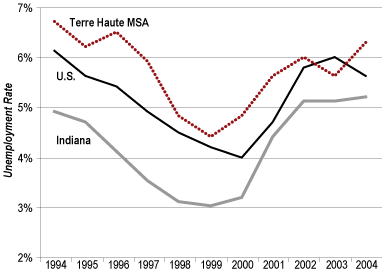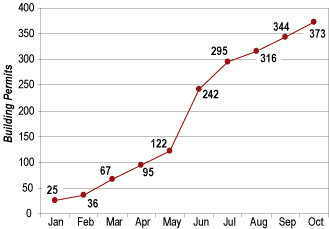Terre Haute
Indiana State University, Terre Haute
The economy of Terre Haute, long lagging that of the state of Indiana, may be ready for a rebound. On the strength of increased residential construction, education and health services employment, and political strength from the mayor’s office, Terre Haute may be prepared to break out of its decades-long pattern of anemic economic performance.
Terre Haute’s economic history, as perceived around the state, is one of decline. Manufacturing employment, once the engine for economic activity in the community, is 10 percent lower in 2004 than it was in 1995. Terre Haute has not landed a major new employer to the area since Aisin located in the Vigo County Industrial Park early in the decade. Continued high energy prices threaten the economic health of the local plastics industry. Terre Haute’s unemployment rate has, for a decade, remained above that of the nation and the state. It is worth noting, however, that all have converged in recent years suggesting Terre Haute’s days of seriously lagging the state and nation may be drawing to a close (see Figure 1).
Figure 1
Unemployment Rate Annual Averages, 1994 to 2004*

Construction industry employment is the highest it has been in a decade and new residential building permits are running ahead of their 2002–2003 pace (see Figure 2). The 641-Bypass connecting I-70 to southbound U.S. 41, though proceeding slowly, offers the potential for growth on the southeast side of Vigo County. Developers continue exploratory work near the I-70 and State Road 46 interchange, leading to the possibility of a major new retail area at this relatively undeveloped site.
Figure 2
Terre Haute Metro Cumulative Year-to-Date Building Permits, 2004*

Elsewhere, health and education employment continues to grow as Vigo County’s two major hospitals and four major institutions of higher education are once again (though to varying degrees) expanding services. Though this sector was flat from 1997 to the beginning of 2003, from March 2003 through 2004, the sector has added more than 1,000 jobs.
The political realm, long an arena for stagnation and complacency, has signs of new life as the people of Terre Haute and Vigo County give the new mayor, Kevin Burke, an 80 percent approval rating and supported candidates for county council who endorse the continuation of the new CAGIT and EDIT taxes (1). Mayor Burke’s approval exists despite, or perhaps because of, taking on the tough challenges of what to do with the long-abandoned Terre Haute House and the city’s crumbling waste-water treatment facility, while he has endorsed the continued use of the CAGIT and EDIT taxes for economic development. Though definite plans have not been set in any of these areas, the willingness of the citizens of Vigo County and its elected leadership to look to new ideas for economic growth suggests a level of confidence in the community not seen in years.
Notes
- CAGIT, the County Adjusted Gross Income Tax, may be adopted by the county council at a rate of 0.5 percent, 0.75 percent or 1 percent. More than half of CAGIT revenue must be used for property tax relief. EDIT (also known as CEDIT) is the County Economic Development Income Tax and can be adopted at rates up to 0.5 percent (although there are caps imposed when combining types of county income taxes). Revenue is divided among the county, cities, and towns and must be used for economic development or public capital projects.
Also in this Issue…



